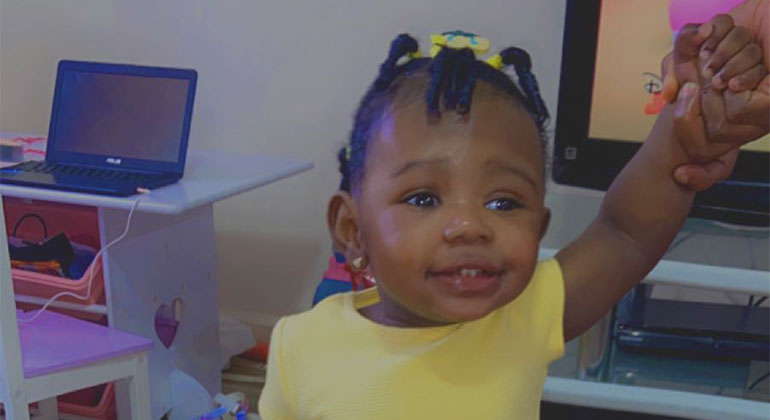
Mom’s Persistence Pays Off: Infant Daughter Gets Correct Diagnosis and Successful Surgery at Mount Sinai’s Department of Neurosurgery
When Peyton Drumgold was born, her mother, Tamara Spencer, noticed that her head was oddly shaped. The right side of her forehead by her eyebrow bone looked “pushed in and her eye didn’t open” as she explains. Her family and friends gushed that her daughter was beautiful. Her pediatrician told her not to worry; Peyton would grow out of it. A neurologist advised the same thing. As the months went by, Peyton met all her developmental milestones, physical and intellectual. But her head shape remained. No one seemed concerned, except Tamara.
When Peyton was six months old, Tamara, still unconvinced, took her to be checked by Walter Molofsky, MD, Director of Pediatric Neurology at the Mount Sinai Health System. Dr. Molofsky ordered a CT scan, which showed that a skull “seam” or suture on the right side of Peyton’s skull had fused prematurely. Her head didn’t have the “soft spot” that most babies have, making it hard for the head to properly grow to accommodate her growing brain. Left untreated, this condition would cause an increasingly lopsided appearance and might also affect Peyton’s cognitive development. The diagnosis: right unicoronal craniosynostosis.
Peyton’s mother met pediatric surgical specialists at the Mount Sinai Health System’s Cleft and Craniofacial Center, Peter F. Morgenstern, MD, Assistant Professor of Neurosurgery and Pediatrics and Peter J. Taub, MD, Professor of Surgery, Pediatrics, and Neurosurgery, who advised her that the most effective treatment is surgery to reshape part of the head and open the closed sutures.
Tamara inquired whether helmeting should be an option for Peyton, but she learned from the Mount Sinai surgical experts that helmet therapy is used in select conditions, such as positional plagiocephaly (where the bones of the skull are unattached and not fused) or following minimally invasive surgery for the management of craniosynostosis early in life. Helmets cannot correct the abnormalities caused by craniosynostosis on its own. Each child’s care is individualized in consultation with the entire craniofacial team and for Peyton, she was older with thicker bones. Drs. Morgenstern and Taub advised that she required open cranial vault remodeling which would fully correct the abnormality without the need for helmet postoperatively.
Peyton’s surgery was originally scheduled for mid-April, when New York City was the national epicenter of the COVID-19 pandemic. Drs. Morgenstern and Taub postponed the procedure until May but didn’t want to hold off much longer. Further delay would cause the skull to continue to thicken, making it harder to correct.

Tamara was nervous about Peyton having the procedure during the pandemic. Consulting with the doctors, Tamara decided that the benefits outweighed the risks from COVID-19. Once Tamara arrived at Mount Sinai Kravis Children’s Hospital, she was no longer worried about Peyton or herself catching COVID-19. Peyton received a test two days before the procedure (it was negative) and was in a single room, isolated from other patients. All the staff wore masks at all times.
The six-hour procedure was performed at Kravis by Drs. Morgenstern and Taub with Peyton tolerating the surgery exceptionally well, jumping and dancing within a day. The one-visitor policy was amended, enabling Tamara and her mother to switch off, so one of them was always with Peyton. After spending a few days under observation in the hospital, she returned home with her family.
Now, just over one year old, Peyton is doing well, talking and walking and getting into everything. "We have to watch her every second," says Tamara. As for the care at Mount Sinai, Tamara is thrilled. "From before the procedure until we left the hospital, everyone was wonderful," she says. "Any time I had a question, someone was there to answer it. They were great." When asked about her daughter’s appearance, Tamara replied, "She’s still beautiful. She’s perfect."